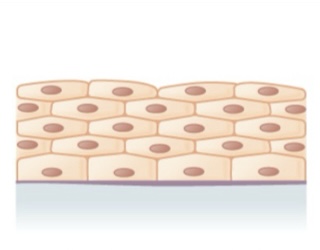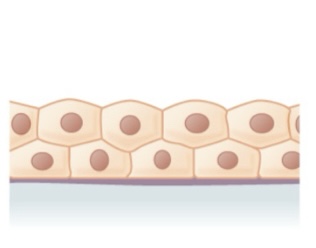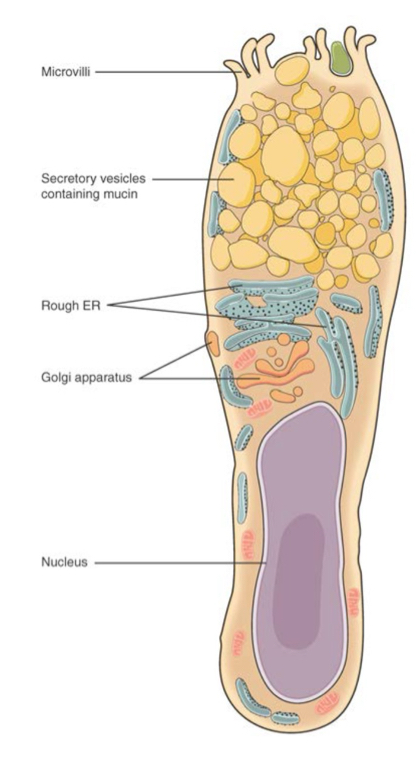Chapter Four A & P I
1/67
There's no tags or description
Looks like no tags are added yet.
Name | Mastery | Learn | Test | Matching | Spaced |
|---|
No study sessions yet.
68 Terms
What are the four types of tissues in the body?
Epithelial
Connective
Muscle
Nervous
epithelial tissue
lines exterior surfaces of body, lines internal cavities, and forms certain glands
Connective tissue
Binds the cells and organs together, protects, supports and integrates all parts of the body
Muscle tissue
Excitable, contracts to provide movement
Nervous tissue
excitable, propagates electrochemical signals (nerve impulses) to communicate between different regions of the body.
What are the functions of epithelial tissue ?
Protection - skin: barrier to keep out bacteria and chemicals
absorption- digestive system: absorption of nutrients.
Filtration- kidneys: absorption and filtration of water and nutrients
Secretion- sweat glands: secrete sweat
epithelial tissue characteristics
asymmetrical
Connected by junctions
Attached to basement membrane and then to connective tissue.
High rate of regeneration and turnover
Apical side of epithelial tissue?
Cavity, intestinal lumen, stomach lumen, inside of esophagus, inside of tracheae, nasal cavity, mouth cavity.
Basal side of epithelial tissue?
basement membrane (attached to connective tissue)
What are the three types of cell junctions that hold epithelial cells together?
Tight junctions: no transport between cells
Anchoring junctions: help stabilize epithelial tissues
Gap junctions: forms pores between cells, continuous cytoplasm
what are some examples of tight junctions
Intestines
What are some examples of anchoring junctions?
Desmosomes-connects cells to each other
Adherens junctions- connect cells to each other
Hemidesmosomes- connects cells to base
gap junctions examples?
mymetrium of uterus
How is epithelial tissue classified?
Shape and layers
how is glandular epithelial tissue classified?
gland type
Secretion method
Secretion content
classifications of epithelial tissues according to shape
Squamous: thin, scale-like
Cuboidal: cube-like wide
Columnar: more long than wide

what is this?
Stratified squamous epithelium

What is this?
stratified cuboidal epithelium

What is this?
stratified columnar epithelium
What are the classification of epithelial tissues according to layers?
Simple-single layer
Stratified- several layers
Pseudostratified- single layer of irregular cells
Classification of glandular epithelial tissues according to gland type
Endocrine: secretions directly into surrounding tissues and fluids. Example: hormones
Exocrine: secretions leave through a duct that opens to the external environment. Examples: mucus, sweat, saliva, and breast milk
What are exocrine glands cell type?
classified as either unicellular or multicellular

What cell is this?
goblet cell
What are goblet cells?
mucous-secreting single gland cells of the small intestine
mucous is a watery-viscous secretion that contains the glycoprotein mucin
classification of exocrine glandular epithelial tissue according to secretion method?
merocrine: exocytosis of vesicles in apical surface- saliva, eccrine sweat glands
Apocrine: a portion of the cell pinches off- apocrine sweat glands in auxiliary and genital areas, oily
Holocene: whole cell is shed- sebaceous glands in skin, hair
What are sebaceous glands?
aka Holocene glands secrete oils that lubricate and protect the skin
Destroyed after releasing their contents and new cells form
connective tissue functions?
connects tissues and organs (tendons)
Supports (skeleton)
Protects soft tissue (fibrous capsules and bones)
Defense against invading organisms (blood cells)
Transport of fluid, nutrients, waste, chemical messengers(lymph, blood)
Store energy and thermal insulation (adipose tissue)
what are the three comments connective tissue is made up of?
Cells
Protein fibers
Ground substance
what is secreted by connective tissue cells?
The matrix
what is the matrix?
protein fibers + ground substance
what are some connective tissue cells?
Fibroblasts- most common, secrete matrix
Fibrocytes: second most common, less active to divide
Adipocytes: store triglycerides for energy, cushion, thermal regulation, white and brown
Mesenchymal cell: multi potent stem cell, can differentiate into any connective cell, important for repair
Macrophage: phagocytic blood cell, engulf invaders
Mast cells: immune cells, release histamine and heparin during injury
connective tissue fibers?
Collagen fibers: tensile strength, fibrous (long) protein units
Elastic fibers: stretch, elastin and other proteins
Reticular fibers: anchoring and support, branched collagen fibers in a network. Support cells of liver, spleen
connective tissue ground substances?
composed of polysaccharides and proteins
What do fibroblasts do?
secrete protein fibers and ground substances
where are protein fibers embedded?
ground substance
Connective tissue proper
dense and loose connective tissue
fibroblasts produce this fibrous tissue
Includes fixed cells, fibrocytes, adipocytes, and mesenchymal cells
Supportive connection tissue?
bone and cartilage
Fluid connective tissue ?
lymph and blood
What are the three types of cells in loose connective tissue?
Adipocytes
Areolar tissue
Reticular tissue
Adipocytes
fat storage, insulation from cold temperature, and mechanical injuries. Store fat for energy. White and brown fat.
Areolar tissue
filles space between muscle fibers, surrounds blood vessels and lymph vessels, connective tissue support for most epithelial membranes. provides a supportive framework for soft organs.
Reticular tissue
mesh-like network for lymphatic tissue, spleen and liver
Dense connective tissue?
contain more collagen fibers than loose connective tissue
What are the two types of dense connective tissue?
dense regular: connective tissue fibers are parallel to each other. Ligaments and tendons
Dense irregular tissue: the direction of fibers is random. Arterial walls, skin, joint capsules. Mesh-like network.
What are the two major forms of supportive connection tissue?
1) cartilage
2) bone
supportive connective tissue function?
allow body to maintain its posture and protect internal organs
Cartilage
-chondrocytes (cartilage cells) embedded with collagenous fibers (protein fiber) in a firm matrix of chondrites sulfates (polysaccharides)
avascular, nutrients need to diffuse through the matrix so slow healing
Where does cartilage occupy?
lacunae.
What are the three types of cartilage?
hyaline
Fibrocartilage
Elastic cartilage
hyaline cartilage
provides support with some flexibility- ex is embryonic skeleton before bone formation
Fibrocartilage
provides compressibility and can absorb pressure- ex is intervertebral discs
Elastic cartilage
provides firm but elastic support - ex is the external ear
Bones
the hardest connective tissue
Function of bone?
protection to internal organs and supports the body
highly vascularized tissue, can recover from injuries fast
what is the extracellular matrix of bones?
Collagen fibers embedded in hydroxyapatite (a form of calcium phosphate)
What are the cells of the bone?
osteocytes are located within lacunae
Fluid connective tissue?
blood- contains erythrocytes and various types of leukocytes
Lymph- a liquid matrix + white blood cells
both circulate in a liquid extracellular matrix
Where are all blood cells derived from?
hematopoietic stem cells of bone marrow
Erythrocytes
red blood cells that transport oxygen and some carbon dioxide
Leukocytes
white blood cells, defend against invading organisms
Platelets
cell fragments involved in blood clotting
Charcteristics of muscle tissue?
allows movement
Excitable (responds to a stimulus)
Some muscle movement is voluntary and other movements are involuntary
What are the three types of muscle tissue?
Skeletal (voluntary) - attached to bones around entrance points to body
striated and multi-nucleated
Cardiac (involuntary) - located in heart
striated and mostly a single nucleus
Smooth (involuntary)- located in walls of major organs and passageways
a single nucleus and no striations
Nervous tissue characteristics
excitable
Two types: 10% neurons, 90% glial cells(cells that support neurons)
The synapse is between neuron-neuron or neuron-target cell
Neurotransmitters
The neuron
the cell body is called the soma
The dendrites on the soma receives incoming signals
The axon starts and carries the action potential to another excitable cell
nervous tissue
made up of neurons and neuroglia
Send and receive impulses
tissue healing
Collagen fibers are laid down randomly by fibroblasts and white blood cells are attracted by release of inflammatory chemicals and seep into injured area
Epithelial cells multiply a fill over the granulation tissue and the restored epithelium thickens. The area matured and contracts and there becomes an underlying area of scar tissue